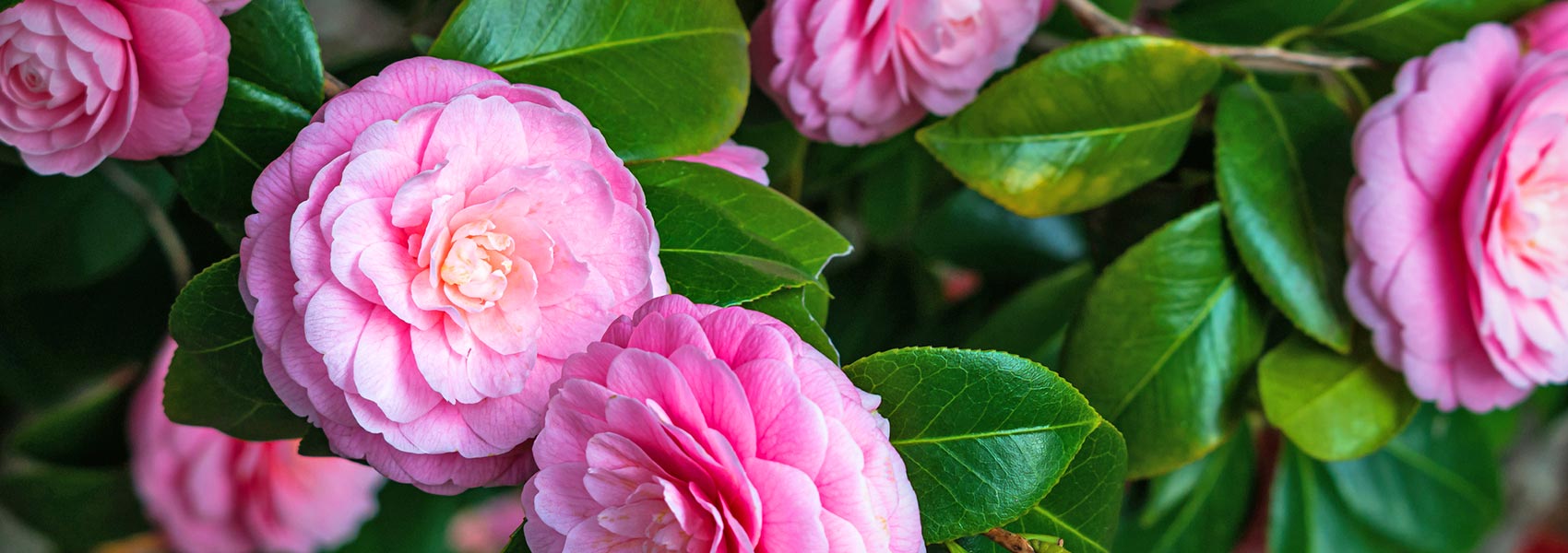Self Guided Garden Tour
Enjoy our Camellia's in our Healdsburg garden tour (self-guided)
When you come to visit, we invite you to take a self-guided Healdsburg garden tour of our Camellia Gardens. Tour sheets are available at the Inn. Below is a systematic guide to touring the garden.
Begin your Healdsburg garden tour at the Camellia Inn:
Starting at the Fish Pond patio, and facing the tree-lined North Street:
- The light and airy Evergreen Dogwood is on your left. It has the distinguishable yellow/green flowers in summer, which develop pink overtones as they mature. With its strawberry-like pods, the tree was planted to screen the side of the house. It is a very rare variety. Lucy Lewand’s sister Chris grew it from seed.
- The magnificent, old Oriental Magnolia (Tulip Tree) has been a joy for many years. When Dr. Seawell used the home as the town’s first hospital, his patients delighted in seeing the tree’s cheerful blossoms in the spring. An heirloom dating to the 1820s, it was named after Etienne Soulange-Bodin (1774-1846), a Napoleonic soldier who survived the defeat at Waterloo, and who afterward became director of The Royal Institute of Horticulture near Paris, where he raised his hybrid seedlings. He first saw his hybrids flower in 1827 and knew at once that he had something.
- Crossing over the brick patio to the right are some of the old Camellias at the Camellia Inn planted by the doctor and his wife. The Lewands have added more than 40 additional varieties of camellias since starting the Inn. Many of the later additions were purchased from or donated by the late Jim Smith, a local artist. He tenderly grafted numerous plants. Some are more than 30 years old.
- The Japanese Maple was added in 1988 as shade for the camellias.
- The Goldfish Pond lies in the center of the patio; a focal point and favorite spot for guests. Peek around the water lilies, to glimpse the glittering scales of goldfish. Built in 1927, the tile and frogs are from the famous Rookwood art pottery company in Ohio. This was the first fishpond in town. All the neighbors attended Mrs. Seawell’s grand unveiling party.
- The towering Blue Spruce is just in front of the Fish Pond. It is a medium-sized evergreen tree growing to 25-30 m tall, exceptionally to 46 m tall, and with a trunk diameter of up to 1.5 m. The bark is thin and scaly, flaking off in small circular plates 5-10 cm across. The crown is conic in young trees, becoming cylindrical in older trees. The shoots are stout, orange-brown, usually glabrous, and with prominent pulvini.
- Close by is the Sasanqua Camellia with its distinctive serrated leaves and small flowers. This is an early bloomer with its blossoms at their height in November. This is a vigorous and chic flower. Sasanqua camellias are native to China and Japan where they have contributed their beauty to gardens for centuries.
- The fragrant rose bushes lining the sidewalk entrance thrive in Northern California and especially in Sonoma County. Blooms are best March to July.
- The two dogwoods at the sidewalk’s edge are gracious greeters of our guests. One is a white Western Dogwood and the other a Pink Flowering Dogwood. The Western Dogwood is generally described as a perennial tree or shrub. It is native to the United States and has its most active growth period in the spring and summer. The Western Dogwood has green foliage and conspicuous white flowers and white fruits or seeds. The Pink Flowering Dogwood tree has a tiered branching habit that flaunts a wonderful display of color from late winter to early spring when covered in large pink “blooms.” Fall brings red to maroon foliage with clusters of deep red berries that birds simply love.
- Walk up the curved path from the iron gate to our beds of ever-changing seasonal flowers.
- Towering next to the house is a Cedar of Lebanon tree that stands about 65′ tall. This giant was planted around 1870. Luther Burbank introduced Cedars of Lebanon trees in Sonoma County. According to Wikipedia, Cedar of Lebanon was important to various civilizations. The trees were used by the ancient Phoenicians for building and military ships, as well as houses and temples. The Egyptians used its resin for mummification, and its sawdust was found in the pharaoh’s tombs. The Sumerian Epic of Gilgamesh designates the cedar groves of Lebanon as the dwelling of the gods to where Glgamesh ventured. They once burned cedar in their ceremonies. Jewish priests were ordered by Moses to use the bark of the Lebanon Cedar in circumcision and treatment of leprosy.
- To the east side of this giant is a graceful Dwarf Japanese Maple. Beautiful in every season, the Japanese Maple provides our garden with color, texture, culture and great variety.
- Along the east boundary of the property a delicate peony grows in the corner area. The large, showy flowers of peonies are produced in mid-to-late spring.
- Next to the peony is a Prince Albert Camellia. Mrs. Seawell purchased it in the 1940s from a local nursery.
- The three lanky, spindly camellias that follow the Prince Albert have large and spectacular flowers. They belong to the reticulata variety of Camellias. This species of Camellia, which is native to the Yunnan Province of southwestern China, is cultivated both for tea oil and for its ornamental value.
- The next camellia is obviously a primitive seedling rootstock variety, whose grafts did not take. Its small, simple flowers produce numerous seed pods. This is the largest camellia specimen at the Inn. Note the many offsets (sports) emanating from its surrounding root base and seeds.
- Adjacent to the birdbath is another tulip tree. They bloom beautifully in Healdsburg.
- A sun-loving rhododendron garden lies in the middle of the front yard. Smaller azaleas add accent.
- Growing lavishly on the wooden overhang next to the house is a fragrant white wisteria. It has late spring and early summer flower clusters.
- To the left of the steps you’ll note a series of pink, white and red Dolores Hope Camellias. They are camellias with exclusively very large blooms (more than 5 inches).
- Down the steps from the front yard, under a bower of wisteria, to the driveway to your left arecamellias of the Japanese variety. They are the most common camellia and are noted for their dense foliage and many different flower shapes.
- In the rear of the Inn and around the pool area at the foot of the drive is an albizzia tree (a mimosa look-alike). Albizzia julibrissin is known as the “tree of collective happiness” by the Chinese because of its ability to “promote joy, assuage sorrow, brighten the eye, enliven the heart, as described in the most revered herbal texts written nearly 500 years ago. Long before that time, Chinese people have recommended its use for anyone who is suffering from sadness or grief because of severe disappointment or loss.
- To your immediate right is a pomegranate tree. The lush fruit makes for colorful holiday desserts and decorations.
- Next is a lovely row of delicate lilacs. Their hanging blossoms are both graceful and very fragrant.
- The lattice screen is entwined by a very old purple flowered airy wisteria.
- The two tall trees next are sturdy oaks. You’ll see many oak trees in the Northern California countryside.
- A fluffy flower, appropriately named Snowball, sits behind the oaks. The clustered flowers bounce cheerfully when in full bloom.
- Next to it is a round leafed Red Bud Tree.Next to the pool fence is a grand crape myrtle. In summer, when in full bloom, it’s quite colorful and vibrant. These trees are very slow growing and very old.
- Spectacular azaleas line the fence. Azaleas, like rhododendrons, do exceptionally well in Northern California. Note the huge, proud red azalea. This lovely bush blooms in February.
- To your right is another specimen size crape myrtle.
- Surrounding the pool area is a bountiful display of roses and camellias.
- Look to the wall across from the pool. Trumpet vines create a backdrop. This is a summer blooming vine.
- Tuberous begonias and ferns grow staunchly in the half-pots on the pool wall.
- Dwarf navel orange and apple trees are by the swimming pool next to lovely oriental magnolia tulip trees.
- Persimmon trees grow just behind the yard.

